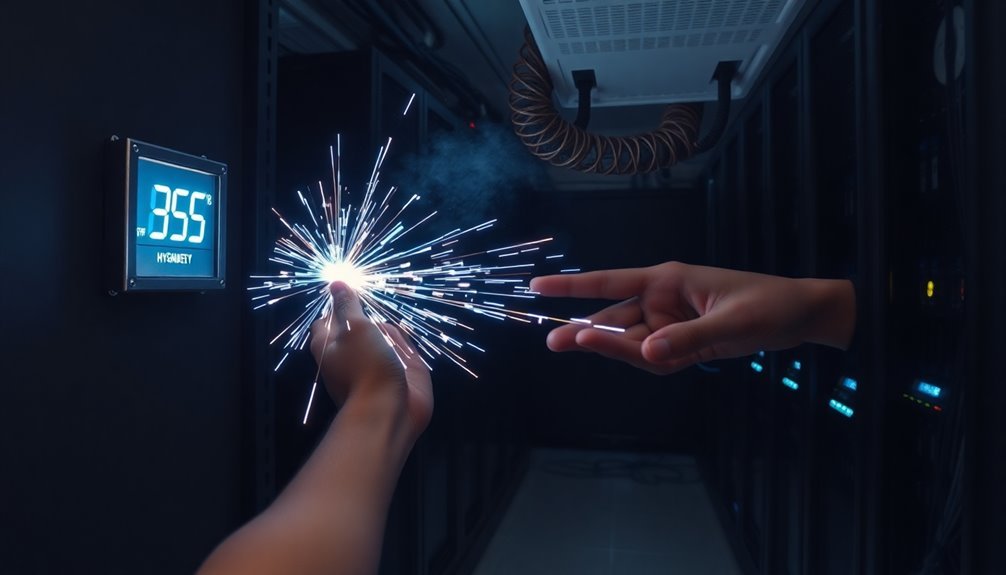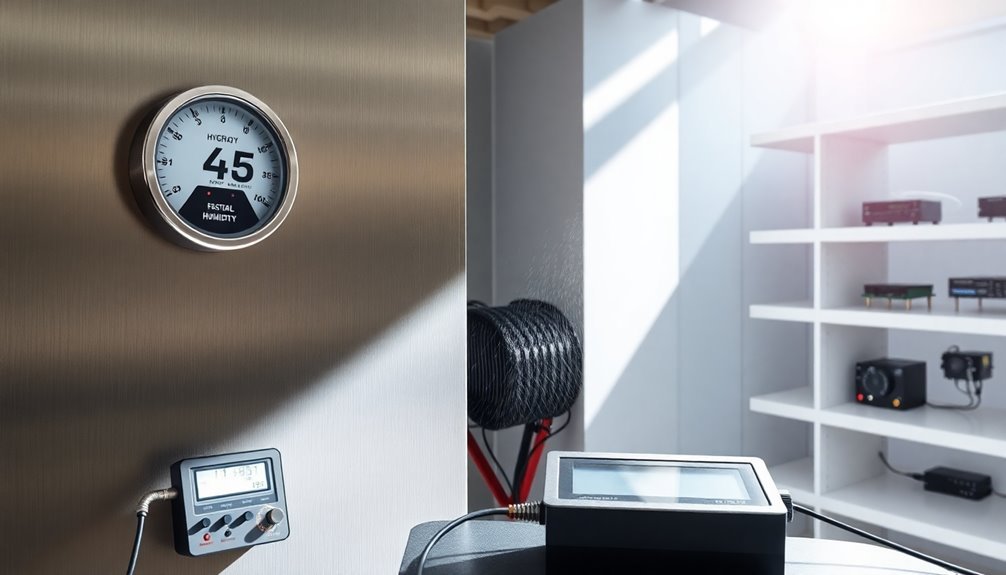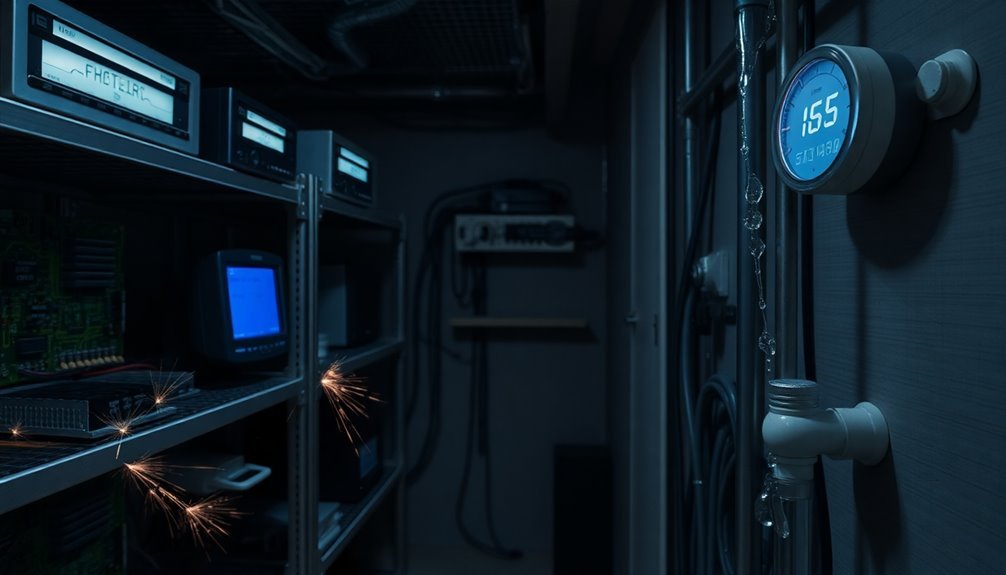You'll want to monitor room humidity to prevent static electricity buildup that can damage electronics and cause uncomfortable shocks. Static charges develop more easily when humidity drops below 40% relative humidity (RH), while maintaining levels between 40-60% RH helps dissipate these charges naturally. The moisture in the air acts as a conductor, safely dispersing static before it can accumulate to dangerous levels. Proper humidity monitoring protects your equipment, prevents manufacturing disruptions, and creates a more comfortable workspace. Understanding the relationship between humidity and static control can save you significant time and money in the long run.
Understanding Static Electricity Basics

Static electricity emerges when everyday materials exchange electrons through contact, friction, or separation. When you rub two materials together, electrons transfer from one surface to another, creating an imbalance of charges. Low humidity levels significantly increase static charge buildup.
The material that loses electrons becomes positively charged, while the one that gains electrons becomes negatively charged.
Understanding this phenomenon requires knowledge of basic atomic structure. Every object you encounter consists of atoms containing protons (positive), electrons (negative), and neutrons (neutral). In their natural state, these objects maintain a balanced number of positive and negative charges.
However, when materials interact through friction, contact, or other means, this balance gets disrupted.
You'll notice static electricity's effects in common situations. It's why your hair stands up after removing a winter hat or why balloons stick to walls after rubbing them.
While these examples seem harmless, static electricity can cause significant problems in production environments. Even low voltage levels under 1KV can damage sensitive equipment or disrupt manufacturing processes.
The charge buildup continues until conditions allow for discharge, either through a circuit or when the accumulated charge finds a path to flow.
Room Humidity Effects on Static
You'll find that static electricity becomes a significant concern when room humidity drops below 40%, creating dangerous conditions for electronic equipment and sensitive materials.
Your best defense against static build-up lies in maintaining humidity levels between 40% and 60%, as moisture in the air acts as a natural conductor to dissipate static charges. The triboelectric effect occurs when materials rub together, transferring electrons between surfaces.
When you raise humidity above 55%, you're effectively preventing static electricity by making the air more conductive, which helps distribute and neutralize excess charges before they can accumulate.
Static Build-up Danger Zones
Understanding the relationship between room humidity and static electricity can help prevent costly equipment damage and safety hazards. When your facility's humidity drops below 40%RH, you'll face the highest risk of static build-up and dangerous electrostatic discharges.
Even in rooms with moderate humidity levels between 40-55%RH, you're not completely safe from static-related issues, as localized dry spots can still develop around heat-generating equipment. Industries like printing and packaging frequently experience these challenges.
To effectively manage static electricity risks in your facility, you'll need to monitor these critical danger zones:
- Areas with humidity below 40%RH, where static build-up becomes severe and can damage sensitive electronics or create safety hazards for personnel
- Locations near heat-generating machines that create dry micro-climates, even when overall room humidity seems adequate
- Spaces with moderate humidity (40-55%RH) that still require additional static control measures, especially in critical manufacturing or data center environments
You'll achieve the best static control when maintaining humidity levels above 55%RH, but remember that consistent monitoring is essential, as localized variations can create unexpected static dangers even in generally humid environments.
Moisture's Role in Prevention
Moisture in the air acts as nature's static electricity neutralizer, creating a natural pathway for static charges to dissipate. You'll notice static problems diminish substantially when you maintain relative humidity levels above 40%, with the best protection occurring at 55% or higher. Drier and colder conditions typically increase static electricity problems during winter months.
Here's how humidity levels affect static control in your environment:
| Humidity Level | Static Control Effect |
|---|---|
| Below 40% RH | High risk of static buildup; charges persist longer |
| 40-55% RH | Reduced static formation; partial protection |
| Above 55% RH | Best static elimination; charges dissipate quickly |
| 60-65% RH | Maximum protection; rapid charge dissipation |
| Above 65% RH | Complete static control; potential moisture issues |
You can effectively manage static electricity by using evaporative humidifiers or atomizing nozzles to maintain proper moisture levels. If you're working in an industrial setting, consider installing localized spray systems near heat-generating equipment. Remember that temperature affects humidity levels, so you'll need to monitor both factors. By maintaining the best humidity, you'll not only prevent static buildup but also improve product quality, enhance workplace safety, and boost overall productivity.
Optimal Humidity Levels for Prevention

Maintaining your room's relative humidity between 40-60% will help prevent static electricity, with levels above 55% completely eliminating static buildup.
You'll need to adjust your humidity control methods seasonally, as winter heating typically creates drier conditions that require more active humidification.
For effective static prevention, you should monitor humidity levels in each room where static is a concern, particularly in spaces with electronic equipment or manufacturing processes.
The presence of moisture in the air helps conduct and disperse electrical charges, preventing them from accumulating on surfaces.
Ideal Percentage Range
Proper humidity levels stand out as the most critical factor in preventing static electricity buildup. When you're managing an environment prone to static electricity, maintaining the right humidity range becomes essential for effective static control.
You'll find that humidity below 40% creates ideal conditions for static charges, while levels above 55% virtually eliminate the problem.
To effectively manage static electricity through humidity control, focus on these key ranges:
- Keep humidity above 40% as your minimum target – below this threshold, you'll experience frequent static buildup and discharges that can damage sensitive equipment or create uncomfortable conditions.
- Aim for the 40-55% sweet spot – in this range, you'll notice substantially reduced static occurrences while maintaining a comfortable environment that isn't too damp.
- Consider pushing above 55% in static-sensitive areas – this level completely eliminates static concerns, though you'll need to balance this against other environmental factors.
You can achieve these ideal levels using evaporative humidifiers, air purifiers with built-in humidity control, or localized humidification systems. Using a digital indoor hygrometer can help you accurately monitor and maintain these humidity levels.
Remember that removing carpeting and minimizing heat-generating equipment will help maintain your target humidity range more effectively.
Seasonal Control Adjustments
As seasons change, you'll need to adjust your humidity control strategies to effectively prevent static electricity. During winter months, you'll face increased challenges as cold air typically contains less moisture, requiring more aggressive humidification efforts to maintain ideal levels between 45-55%RH. In summer, you may need to focus on dehumidification to prevent condensation issues while maintaining static control. Laboratory equipment performance and longevity depend on maintaining proper humidity levels.
To maintain effective static control throughout the year, you'll want to implement automated monitoring systems that can adjust to seasonal variations. These systems should continuously track humidity levels and make real-time adjustments to keep your environment stable.
| Season | Primary Challenge | Control Strategy |
|---|---|---|
| Winter | Low humidity | Increased humidification |
| Spring | Fluctuating levels | Regular monitoring |
| Summer | High humidity | Dehumidification |
You'll achieve the best results by maintaining humidity levels around 50%RH year-round. Keep in mind that levels below 45%RH substantially increase static risks, while anything above 55%RH can create condensation problems. Use localized humidification systems in areas with specific needs, and guarantee your HVAC system receives regular maintenance to operate efficiently across all seasons.
Room-by-Room Monitoring Tips
Strategic room-by-room monitoring forms the backbone of effective static control in any facility. You'll need to understand that different areas in your building require varying humidity levels based on their specific functions and equipment.
For electronics manufacturing and cleanrooms, maintaining 40-60% relative humidity (RH) prevents static while protecting moisture-sensitive components.
To effectively monitor humidity room by room, focus on these essential tips:
- Install continuous monitoring sensors in each room, paying special attention to areas with heat-generating equipment that can create localized dry air pockets requiring additional humidity control.
- Maintain precise RH levels based on room function: 50% for cleanrooms and laboratories, above 55% for manufacturing and printing areas, and 40-60% for general office spaces.
- Deploy localized humidification solutions, such as evaporative humidifiers or spray systems, in areas where your HVAC system can't maintain consistent levels.
Common Static Control Challenges
The management of static electricity in production environments presents several persistent challenges that can impact both quality and efficiency. You'll find that static-related issues often emerge from multiple sources simultaneously, making it difficult to pinpoint the exact cause of production problems.
In your facility, you're likely to encounter static charges from incoming materials, equipment, and even your workforce's clothing. These charges can lead to serious production disruptions, including machine slowdowns, quality defects, and safety hazards.
| Source | Challenge | Impact |
|---|---|---|
| Personnel | Clothing/shoes generate static | Increased risk of ESD damage |
| Equipment | Test equipment charges | Machine malfunctions |
| Materials | Incoming shipments | Contamination risks |
| Environment | Low humidity | Higher static generation |
| Production | Friction/separation | Product quality issues |
While humidity control can help mitigate these challenges, you shouldn't rely on it exclusively. Even with ideal humidity levels of 30-40%, you'll need to maintain thorough static control measures. The plastics and printing industries face particularly difficult challenges, as static can cause everything from dust attraction to sheet misalignment, potentially resulting in significant product rejection rates and increased operational costs.
Humidity Monitoring Equipment

Selecting from among today's humidity monitoring equipment requires careful consideration of your facility's specific needs and environmental challenges. You'll find several sensor types available, each suited for different applications.
Capacitive sensors excel in HVAC systems and general environmental monitoring, while thermal conductivity sensors are your best choice for harsh, high-temperature environments like ovens and kilns.
For effective static control, you'll want to integrate these sensors with appropriate humidity management systems. You can choose between direct room humidifiers for large spaces, localized spray systems for specific machinery, or thorough HVAC systems with built-in humidity control.
- Consider remote monitoring systems if you need real-time tracking and immediate notifications of humidity fluctuations – they'll save you time on manual checks.
- Install electrostatic sensors alongside humidity monitors to get a complete picture of both static charge and moisture levels in your facility.
- Implement direct room humidifiers if you're managing large spaces like printing halls, where maintaining consistent humidity levels is essential for static control.
The right combination of monitoring equipment and humidity control systems will help you maintain ideal conditions while preventing static-related issues in your operations.
Health and Equipment Protection Benefits
Proper humidity control's dual benefits extend far beyond basic comfort, protecting both your workforce and valuable equipment. When you maintain humidity levels above 55%RH, you'll substantially reduce static shock risks that can harm employees and damage sensitive electronics. This protection is particularly essential in healthcare settings, where equipment reliability directly impacts patient safety.
You'll notice immediate improvements in workplace health when you control humidity effectively. It helps reduce allergens and bacteria growth, creating a healthier environment for your staff.
Additionally, you're protecting your valuable equipment from static-related damage, which can lead to costly repairs and dangerous malfunctions. Your sensitive electronic components, PCBs, and military equipment will be safeguarded against both static buildup and corrosion.
Your investment in humidity control translates to substantial cost savings through extended equipment lifespan and reduced maintenance needs. Active humidity control systems prevent condensation damage in sealed enclosures, while humidity control sheets offer additional protection for sensitive components.
Cost Savings Through Humidity Management

Smart investments in humidity management can lead to substantial cost reductions across your facility. By choosing gas-fired steam humidifiers over electric units, you'll see significant energy savings that can pay for themselves within two years.
When you combine these systems with reverse osmosis water treatment, you'll eliminate scale build-up issues and reduce both maintenance costs and energy consumption.
Your facility can achieve peak cost efficiency through strategic humidity control implementations:
- Install cold water humidifiers, such as evaporative or spray systems, to leverage thermal energy from the air instead of relying on expensive heat-generating sources.
- Implement scale collector tanks and management systems to minimize maintenance time and reduce the frequency of servicing.
- Utilize smart thermostats and integrated automation systems to optimize energy usage based on real-time temperature and humidity conditions.
For maximum ROI, consider implementing whole-home dehumidifiers and humidifiers with variable-speed compressors. These systems adjust their output based on actual conditions, improving energy efficiency while maintaining proper humidity levels.
You'll also benefit from reduced equipment maintenance costs and extended machinery life spans through proper humidity control.
Frequently Asked Questions
Can Static Electricity Cause Permanent Damage to Smartphone Touchscreens?
Yes, static electricity can permanently damage your smartphone's touchscreen. When you discharge static, it can disrupt the conductive layers and create dead spots or unresponsive areas on your capacitive touchscreen's surface.
How Quickly Does Static Buildup Dissipate After Humidity Levels Are Increased?
When you increase humidity above 40%, you'll notice static charges begin dissipating within minutes. The higher you raise humidity, the faster it'll dissipate – typically taking 5-15 minutes for complete discharge.
Do Air Ionizers Work Better Than Humidifiers for Controlling Static Electricity?
You'll find air ionizers work better than humidifiers for controlling static since they actively neutralize charges rather than just prevent buildup. They can reduce static by up to 90%, while humidity only helps prevent formation.
What Natural Materials Can Help Reduce Static Electricity in Low-Humidity Rooms?
You can reduce static in dry rooms by using cotton, wool, or silk fabrics for bedding and clothing. Adding metal objects, like aluminum foil balls, and placing bowls of water around your space helps too.
Does Clothing Fabric Type Affect Static Buildup Differently at Various Humidity Levels?
Yes, your clothing's fabric type reacts differently to humidity. You'll notice synthetic fibers like polyester build up more static in dry conditions, while natural fibers like cotton perform better when there's more moisture in the air.
In Summary
You'll find that proper humidity monitoring is essential for effective static control in your workspace. By maintaining ideal humidity levels between 40-60%, you're protecting sensitive equipment, ensuring workplace safety, and reducing potential damage to electronic components. You're also saving money through decreased equipment failures and improved operational efficiency. Don't overlook this vital aspect of your facility management – your bottom line depends on it.





Leave a Reply